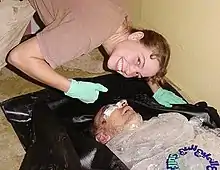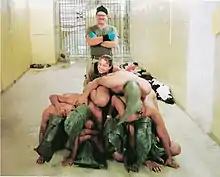Sabrina Harman
Sabrina D. Harman (born January 5, 1978) is a war criminal and former United States Army reservist, one of several persons convicted by the U.S. Army in connection with the 2003–2004 Abu Ghraib prisoner abuse scandal in Baghdad, Iraq, during and after the 2003 invasion of Iraq.
Sabrina Harman | |
|---|---|
 Sabrina Harman posing over the body of Manadel al-Jamadi, an Iraqi prisoner who was tortured to death in United States custody during interrogation at Abu Ghraib prison in November 2003 | |
| Born | January 5, 1978 |
| Occupation | United States Army Reservist |
| Criminal charge | Maltreatment of detainees Conspiracy to maltreat detainees Dereliction of duty |
| Penalty | 6 months' imprisonment Bad Conduct Discharge Loss of all benefits and pay Reduction in rank |
Harman and several other soldiers were tried for allowing and inflicting sexual, physical, and psychological abuse of Iraqi prisoners of war. Harman held the rank of specialist in the 372nd Military Police Company during her tour of duty in Iraq. She was sentenced to six months in prison, reduction in rank and a bad conduct discharge.[1]
Harman was imprisoned in the Naval Consolidated Brig, Miramar in San Diego, California.[2]
Early life and education
Harman was born in Lorton, Virginia. Her father was a homicide detective, and the family often saw photos of dead people at crime scenes. Harman's mother, Robin, has been described as a "forensics buff." Harman graduated from Robert E. Lee High School in Springfield, Virginia.[3]
Career

After the September 11, 2001 attacks, Harman joined the Army Reserves and was assigned to the Cresaptown, Maryland-based 372nd Military Police company. Harman worked for a time as an assistant manager at Papa John's Pizza in Alexandria, Virginia, before her company was activated for duty in Iraq in February 2003, and was deployed to Fort Lee, Virginia for additional training; however, this was in combat support, not I/R (military jargon for "internment and resettlement."). While Harman acknowledged that she knew there was a lot of wrong being done, she claims she knew nothing about there being any official rules about prisoner treatment (i.e., the Geneva Conventions).
Harman's response
- A letter home quoted in The New Yorker:[4]
Oct 20, 03
10:40pm
Kelly,
Okay, I don't like that anymore. At first it was funny but these people are going too far. I ended your letter last night because it was time to wake the MI prisoners and "mess with them" but it went too far even I can't handle whats going on. I cant get it out of my head. I walk down stairs after blowing the whistle and beating on the cells with an asp to find "the taxicab driver" handcuffed backwards to his window with some underwear over his head and face. He looked like Jesus Christ. At first I had to laugh so I went on and grabbed the camera and took a picture. Again I thought, okay that's funny then it hit me, that's a form of molestation. You can't do that. I took more pictures now to "record" what is going on. They started talking to this man and at first he was talking "I'm just a taxicab driver, I did nothing." He claims he'd never try to hurt US soldiers that he picked up the wrong people. Then he stopped talking. They turned the lights out and slammed the door and left him there while they went down to cell #4. This man had been so fucked that when they grabbed his foot through the cell bars he began screaming and crying. After praying to god he moans a constant short Ah, Ah every few seconds for the rest of the night. I don't know what they did to this guy. The first one remained handcuffed for maybe 1½-2 hours until he started yelling with pain for god. So they went back in and handcuffed him to the top bunk on either side of the bed while he stood on the side. He was there for a little over an hour when he started yelling again for god. Not many people know this shit goes on. The only reason I want to be there is to get the pictures and prove that the US is not what they think. But I don't know if I can take it mentally. What if that was me in their shoes. These people will be our future terrorist. Kelly, its awful and you know how fucked I am in the head. Both sides of me think its wrong. I thought I could handle anything. I was wrong.Sabrina
- As quoted in The Washington Post:[5]
[She] said she was assigned to break down prisoners for interrogation. "They would bring in one to several prisoners at a time already hooded and cuffed," Harman said in interviews by e-mail this week from Baghdad. "The job of the MP was to keep them awake, make it hell so they would talk." She said her military police unit took direction from the military intelligence officers in charge of the facility and from civilian contractors there who conducted interrogations.
- At her sentencing:
As a soldier and military police officer, I failed my duties and failed my mission to protect and defend. I not only let down the people in Iraq, but I let down every single soldier that serves today. My actions potentially caused an increased hatred and insurgency towards the United States, putting soldiers and civilians at greater risk. I take full responsibility for my actions. ... The decisions I made were mine and mine alone.[6][7]
Citings
Harman's attorney said he hoped to see the military chain of command put on trial, rather than low-ranking reservists like Harman. "I don't think we can even begin to imagine the kind of environment that she was in. First of all, she wasn't trained to be a prison guard, so she didn't even know the basic rules. She wasn't trained in military intelligence. I don't think any American can really truly appreciate the stress that existed along with the fact they were undermanned and not trained to perform this mission," he said.[8]
See also
References
- "U.S. reservist guilty of Abu Ghraib abuses". msnbc.com. 2005-05-17. Retrieved 2018-05-30.
- Siegel, Andrea F. "Convicted reservist testifies." The Baltimore Sun. July 17, 2005. Retrieved on July 18, 2010.
- Davenport, Christian; Amon, Michael (2004-05-09). "Accused Soldiers a Diverse Group". The Washington Post. Retrieved 2013-09-21.
- Gourevitch, Philip; Morris, Errol (17 May 2008). "Exposure: The woman behind the camera at Abu Ghraib". New Yorker. Retrieved 14 December 2019.
- Spinner, Jackie (21 August 2012). "Soldier: Unit's Role Was to Break Down Prisoners". The Washington Post. Archived from the original on 18 September 2012. Retrieved 14 December 2019.
- Kador, John (1 January 2009). Effective Apology: Mending Fences, Building Bridges, and Restoring Trust. Berrett-Koehler Publishers. pp. 273. ISBN 9781576759011.
- Graveline, Christopher; Clemens, Michael (1 January 2010). The Secrets of Abu Ghraib Revealed: American Soldiers on Trial. Potomac Books, Inc. p. 321. ISBN 9781597976008.
- "Harman Tells Her Story". ABC News. 2005-01-20. Retrieved 2008-06-13.
Further reading
- "She's No Stranger To Grisly Images." CBS: 10 May 2004. 18 June 2004.
- Spinner, Jackie. "Soldier: Unit's Role Was to Break Down Prisoners." The Washington Post: 8 May 2004. 18 June 2004.
- Gourevitch, Philip and Errol Morris. Exposure: The woman behind the camera at Abu Ghraib. The New Yorker: March 24, 2008.
- Morris, Errol. The Most Curious Thing. The New York Times: 19 May 2008
External links
- Sabrina D. Harman at APImages